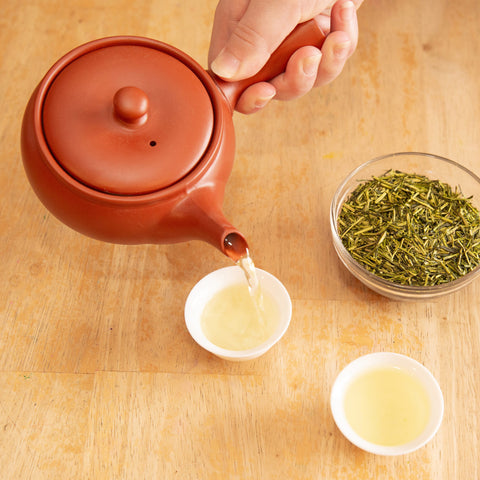What’s So Special About Green Tea?

What is Green Tea?
Green tea has many variations, but there are two defining aspects that brush nuance aside and get to the point:
One – To be blunt, green tea leaves have a green appearance. That’s why it’s called green tea. All tea comes from the same plant (camellia sinensis) and like most plants, its leaves are green.
Two – To be technical, green tea production stops oxidation from happening, because the tea has been “fired” soon after the leaves are picked. Oxidation is the process that turns green tea leaves into black tea. It is the same process that causes an apple slice to brown after a few minutes of being exposed to open air. A tea is “fired” by subjecting it to a short period of high heat to break down the enzymes that facilitate oxidation.

How is Green Tea Made?
In theory, all tea follows a similar process from beginning to end, but differences in the process can significantly change the outcome. As mentioned above, the universal characteristic of green tea is that it is “fired” right away to prevent oxidation. Every other aspect of green tea production is a nuanced choice dependent on regional style. A notable distinction between the different types of green teas is how they are fired. China predominantly “pan-fires” their tea using the dry heat of a wok, oven, or large rotating cylinder. Japan uses a 20-80 second burst of steam to accomplish the same thing. Once fired the tea can be further shaped and dried without oxidation, keeping the tea green in appearance.
How is Green Tea Different from Other Types of Tea?
 Huang Shan Mao Feng green tea
Huang Shan Mao Feng green tea
Green tea has a couple of (nearly) universal qualities:
One – Green teas tend to have a green/yellow leaf appearance. The steeped cup usually produces a light body with mild astringency and a vegetal/grassy flavor.
Two – Green teas can produce bright and bitter flavors if steeped too hot and produce some unpleasant astringency if steeped too long (at least typically more so than other teas). This is why green teas are often steeped at lower temperatures and for shorter times (though not all of them need to be treated so delicately).
Three – Green teas do not age as well as other tea types and usually should be consumed within 12 months of production. After 12 months, most green teas will start to produce a cup that has faded from its original character, but they are still perfectly safe to drink.
Where is the Best Green Tea Grown?
 Wuling Mountain, Hunan province, China
Wuling Mountain, Hunan province, China
Technically, any tea producing country in the world can make green tea. The classification is defined by a process and if one possesses the equipment it can be produced anywhere. This does not mean the result will be good. The tea cultivar, local terroir, and accumulated knowledge matter most. But the best green teas are made in China and Japan.
There are so many different styles of Chinese green tea that it is easier to define them by region than considering China as a whole. Though all traditional Chinese green teas are pan-fired, every other detail of them is distinct in its character. Some Chinese green teas are referred to by elaborate names such as Dragonwell, Bi Luo Chun (Translation: Green Spiral Shell Spring), or Gunpowder. Others reference the place and the leaf style. For example, “Huang Shan Mao Feng” comes from Yellow Mountain (Huang Shan) and “mao feng” is a lightly rolled leaf style that is more sprawling and natural in appearance. Another example would be “Gu Zhang Mao Jian” which comes from the Gu Zhang region of Hunan province and has the “mao jian” leaf style which is thin and elongated, but tightly twisted. All produce a cup of green tea with very different results. The full catalog of famous Chinese green teas is too long to list here.
 Tea fields in Shizuoka, Japan
Tea fields in Shizuoka, Japan
Japanese green teas have their own distinct approach that is more homogenous in character. The differences between region and style are less obvious than in China, but there are certainly wide variations on a theme. Japanese teas tend to be either long, emerald needles or fine green particulate leaf (sometimes both). With rare exception the Japanese use the steaming method to fire their teas and prevent oxidation. The most popular tea is Sencha with all other Japanese teas being defined in their differentiation from Sencha. Japanese teas tend to be rich, brothy, and grassy.
Matcha teas are an entirely different animal. Matcha tea is shade grown tea (e.g., Gyokuro, Kabusecha), that has the leaf matter removed from the fibrous veins and stems. This leaf material (called Tencha) is then milled between two stones until it is a fine powder called Matcha. The Matcha is then whisked into hot water where the liquor and leaf are both consumed. It is not steeped and removed from the water like traditional teas. Matcha is the tea served during the famous Japanese tea ceremony, but culinary grades are now used for all kinds of more casual purposes such as smoothies or baking.
What is the Green Tea Flavor Profile?
 Huang Shan Mao Feng steeped liquor
Huang Shan Mao Feng steeped liquor
There is no single flavor profile for green tea, but they all share some common characteristics. Green teas tend to be simpler and more primordial in flavor so it’s better to judge them on their elegance and clarity rather than for complexity and depth. They tend to be light in body with varying degrees of grassy, vegetal, or herbaceous flavors. Well-made green teas will often be brighter, cleaner, and give a “fresher” profile than green teas that are not well-made. Sometimes sweet, sometimes floral, sometimes brothy, maybe even a little toasty, it all depends on the regional style. As mentioned before, green teas can often produce bitter flavors and an astringent mouthfeel if steeped too hot or too long, but having some of this character in the cup is not always bad and each person should decide for themselves how much they want to invite or avoid these characteristics.
Most Famous Green Teas
There is a big difference between which green teas are popular in America versus China or Japan. American consumers tend to approach green tea for its health benefits which is a large reason for the rise in matcha’s (green tea powder) popularity. But in Japan it is sencha, not matcha, that is widely and casually consumed. In China, each province has its own particular specialties that are most revered. Here is a list of famous green teas from China and Japan:
China:
Japan:
How to Prepare Green Tea
 Karigane green tea in a traditional Japanese Kyusu teapot
Karigane green tea in a traditional Japanese Kyusu teapot
There is no right or wrong way to make green tea. It can be steeped many ways and with many different steeping tools. Here are two basic approaches to it:
Western steeping method:
This is for when you are steeping a smaller amount of leaves for a larger period of time (usually for a single mug or a teapot). This is the most common method in the United States and is symbolized by the tea bag. If you are using loose leaf tea (and we suggest you do) our suggested portions for green tea are:
3-4 grams of dry tea leaves per 8-12 ounces of liquid. Steep for 2-3 minutes at water that is approximately 175-180°f. Re-steep the leaves as desired. Always adjust in ways that suit your tastes.
Traditional Steeping method:
This uses a larger quantity of leaves in smaller amounts of water for shorter periods of time. The leaves will yield many steepings this way. There are numerous ways to do this and they are a lot of fun to explore (and zero reason to be intimidated). The below instructions are a good baseline to start from if using a gaiwan or kyusu teapot, but can be adjusted based on the equipment you are using:
Use approximately one gram of tea per fluid ounce of near boiling water in your gaiwan or teapot. Steep the leaves for approximately 15-30 seconds. Decant into your cup or serving pitcher and enjoy. Repeat as much as the leaves continue to yield satisfactory results – increasing the steep time of each round. Take notice of not only the flavor in the cup but the aroma and the appearance of the steeped leaves. This is all part of the experience. Adjust any above-mentioned factor to suit your tastes.
Green tea can also make for some good iced tea. Check out our iced tea recipes.
Does Green Tea Have Caffeine?
All tea comes for the same plant (camellia sinensis), so all tea has caffeine. There are three factors in your control that determine how much caffeine ends up in your cup:
- How much leaf you use (more leaf equals more caffeine available to extract)
- How hot you steep it (the hotter the water, the more caffeine extracts into your cup)
- How long you steep it (the longer it steeps, the more caffeine is extracted from the leaf)
Commonly, green tea is steeped at lower temperatures (between 175-180 degrees) and for shorter times (2-3 minutes) than black tea. This will produce less caffeine in your cup than if you boiled the water, poured it over your leaves, and let it sit for 4-5 minutes (which is common practice for most other teas). However, there is no rule saying you can’t steep your green tea hotter or longer than your tea supplier suggests. Always adjust to your tastes. There is no right or wrong way to do it.
Is Green Tea Good for Your Health?
Most of green tea’s recent popularity is driven by its reported health benefits.
Tea is one of the healthiest beverages in the world, especially as a preventative approach for long-term physical and mental health. Much of the information out there touts drinking green tea as having the ability to prevent cardiovascular disease, help with weight loss and reduce the risk of cancer. We aren’t doctors or scientists. Just tea connoisseurs. So we don’t make any claims about teas as prescriptive solutions to any particular health issue. But we would love it if you tried some of our amazing green teas.
Here are a couple articles to read if you are interested in learning more about the health benefits of tea:
The health benefits of tea, though considerable, are not the foremost purpose for drinking it. Tea is for your enjoyment - in whatever way you choose to do that. And that enjoyment is good for you all by itself.
